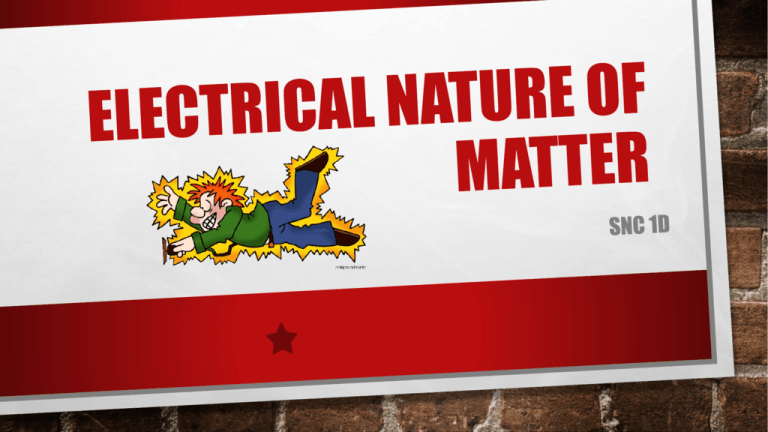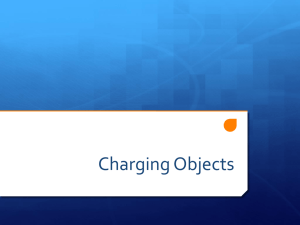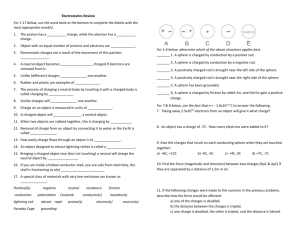Electrical Nature of Matter
advertisement

ELECTRICITY • Everything around you contains electric charges. You aren’t aware of the charges until you make them move from their normal position. • When these charges are forced to move the material has become “charged” with “electricity”. STATIC ELECTRICITY AN IMBALANCE OF CHARGE ON THE SURFACE OF AN OBJECT THAT STAYS IN THE SAME PLACE. RECALL THE STRUCTURE OF THE ATOM… • Positive particles called _____________ and neutral particles called ___________ are found inside the ________________. These particles do not move easily in and out of the nucleus. • Negative particles called ______________ are found in _________________ surrounding the nucleus. These particles can move from one atom to another. ELECTRICAL CHARGES • If an atom gains electrons it becomes • Electrical charges result from the ____________ charged. (There are movement of __________ and not more “” particles than “” particles) from ______________ or • If an atom loses electrons it becomes _____________ charged. • (There are not enough “” particles) • If an atom has equal protons and electrons it is ____________ . ______________ . CHARGING BY FRICTION • Charging by friction occurs when two different neutral objects are rubbed together and electrons are transferred from one object to another. DETERMINING CHARGE • The object with the weakest hold on its electrons transfers them to the other object and becomes positively charged. • The object with the stronger hold on its electrons gains them from the other object and becomes negatively charged. • See page 473 PREDICT THE CHARGE… • When a rubber rod is rubbed with Fur… Rubber has a stronger hold on its electrons and gains electrons from the fur This makes the rod negatively charged and the fur positively charged. PREDICT THE CHARGE… • When a glass rod is rubbed with silk… The silk has a ______________ hold on its electrons, becoming _____________ charged. The glass rod has a ____________ hold on its electrons becoming ______________ charged. YOU MOVE ME ACTIVITY LAW OF ELECTRIC CHARGES •Like charges – repel •Unlike charges – attract •Charged objects attract neutral ones INDUCED CHARGE SEPARATION • Neutral objects are attracted to charged objects due to induced charge separation. • A shift in the position of electrons in a neutral object when a charged object is brought near • Sometimes called polarizing the molecules DETECTING CHARGE • Scientists can detect the presence of electric charges using an electroscope. • Pith ball electroscope – detects the presence of a charge by moving towards a charged object. • Metal-leaf electroscope – detects the presence of charge by causing the leaves to spread apart. CHARGING BY CONTACT • When two objects of different charge are touched together, electrons are transferred from one object to the other. • This results in two objects with the same charge. CHARGING BY CONTACT • A charged object can only charge a neutral object if: • the neutral object is a conductor • if the neutral conductor is supported by an insulator LET’S INVESTIGATE! CHARGING POSITIVELY BY CONTACT CHARGING NEGATIVELY BY CONTACT THINGS TO REMEMBER… • When charging by contact: • The objects must touch each other. • The objects will have the same charge. • The originally charged object will become a little less charged. TIME TO WORK! • Page 471 # 4-9 • Page 477 # 1, 2, 5, 6, 8 VAN DER GRAAF GENERATOR • A metal sphere is supported on an acetate stand. • Inside a rubber belt turns against a metal brush, charging the sphere by friction. • Static charge is transferred to you when you touch the metal sphere. CHARGING TEMPORARILY • A charged object is brought next to but not touching a neutral object. • The electrons move either towards or away from the charged object creating a temporary charge on one side of the neutral object. • Induced Charge Separation CHARGING PERMANENTLY CHARGING PERMANENTLY TIME TO WORK! • Page 489 # 2, 3, 4, 6 INSULATORS AND CONDUCTORS • Conductors are materials that allow electrons to move through them. • Insulators are materials that inhibit or prevent the movement of electrons. • Resistors are a mixture made up of conductors and insulators GROUNDING • The excess charge on an object can be removed by grounding the object. • Grounding involves connecting an object to a large body, like Earth, that is capable of absorbing the charge and effectively remaining neutral itself. USING PAGE 480-481… Conductors Insulators Resistors TIME TO WORK! • Read pg 480-482 and answer pg 482 # 2, 3, 6, 7 • Read pg 492-495 and answer pg 495 # 1, 2, 4




